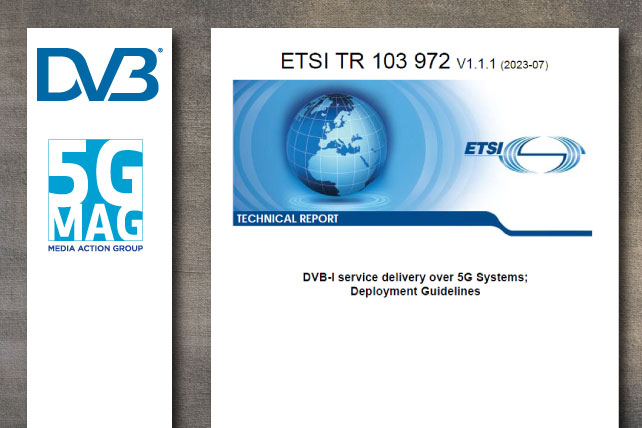A new Technical Report from ETSI, arising out of a collaboration between the DVB Project and 5G-MAG, describes how DVB-I can provide a service layer for any IP-based system, including 5G Media Streaming and 5G Broadcast. Published just ahead of the summer break in Europe, TR 103 972 v1.1.1 shows how relevant components from both the 5G and DVB ecosystems can be smartly combined to address several media service scenarios.
Joint Task Force
The Joint Task Force between DVB and 5G-MAG kicked off early in 2022 with the mission to map the Commercial Requirements for DVB-I service support over 5G networks and systems (DVB BlueBook C100) into a set of deployment guidelines. The resulting report includes high-level summaries of technologies from DVB (DVB-I, codecs, and delivery formats such as DVB-DASH, DVB-MABR and DVB Native IP), from 3GPP (5G System, 5G Media Streaming, eMBMS and enhanced TV), and of LTE-Based 5G Broadcast from ETSI JTC Broadcast. It also sets out the 5G-MAG Reference Tools architecture and client.
The detailed service scenarios covered in the report are:
- Standalone DVB-I service using 5G Broadcast;
- DVB-I service using 5G Media Streaming;
- DVB-I service offering available simultaneously over broadcast and unicast.
A DVB-I over 5G reference architecture is proposed to support all service scenarios and requirements. Each scenario includes workflows with guidance on relevant specifications. Gaps in existing specifications are identified and documented as recommended changes to the relevant specifications under the control of DVB, 3GPP or ETSI.
IBC technical paper
The Joint Task Force was led by Dolby’s Frédéric Gabin (for the DVB Project) and Qualcomm’s Thomas Stockhammer (for 5G-MAG). Richard Bradbury of BBC was also a major contributor to the work. A technical paper on the work by the three will be presented at the IBC2023 conference during a session on 5G technology convergence with broadcast.
More than 65 people from among the memberships of DVB and 5G-MAG joined the Joint Task Force to follow and contribute to the work, representing more than 40 companies in total. With the ETSI report now published, the task force will be wound down and the required follow-up work will continue within the respective organizations.

